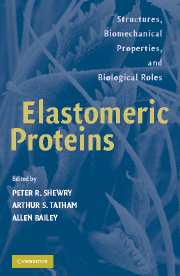Book contents
- Frontmatter
- Contents
- Preface
- Contributors
- Elastomeric Proteins
- 1 Functions of Elastomeric Proteins in Animals
- 2 Elastic Proteins: Biological Roles and Mechanical Properties
- 3 Elastin as a Self-Assembling Biomaterial
- 4 Ideal Protein Elasticity: The Elastin Models
- 5 Fibrillin: From Microfibril Assembly to Biomechanical Function
- 6 Spinning an Elastic Ribbon of Spider Silk
- 7 Sequences, Structures, and Properties of Spider Silks
- 8 The Nature of Some Spiders' Silks
- 9 Collagen: Hierarchical Structure and Viscoelastic Properties of Tendon
- 10 Collagens with Elastin- and Silk-like Domains
- 11 Conformational Compliance of Spectrins in Membrane Deformation, Morphogenesis, and Signalling
- 12 Giant Protein Titin: Structural and Functional Aspects
- 13 Structure and Function of Resilin
- 14 Gluten, the Elastomeric Protein of Wheat Seeds
- 15 Biological Liquid Crystal Elastomers
- 16 Restraining Cross-Links in Elastomeric Proteins
- 17 Comparative Structures and Properties of Elastic Proteins
- 18 Mechanical Applications of Elastomeric Proteins – A Biomimetic Approach
- 19 Biomimetics of Elastomeric Proteins in Medicine
- Index
10 - Collagens with Elastin- and Silk-like Domains
Published online by Cambridge University Press: 13 August 2009
- Frontmatter
- Contents
- Preface
- Contributors
- Elastomeric Proteins
- 1 Functions of Elastomeric Proteins in Animals
- 2 Elastic Proteins: Biological Roles and Mechanical Properties
- 3 Elastin as a Self-Assembling Biomaterial
- 4 Ideal Protein Elasticity: The Elastin Models
- 5 Fibrillin: From Microfibril Assembly to Biomechanical Function
- 6 Spinning an Elastic Ribbon of Spider Silk
- 7 Sequences, Structures, and Properties of Spider Silks
- 8 The Nature of Some Spiders' Silks
- 9 Collagen: Hierarchical Structure and Viscoelastic Properties of Tendon
- 10 Collagens with Elastin- and Silk-like Domains
- 11 Conformational Compliance of Spectrins in Membrane Deformation, Morphogenesis, and Signalling
- 12 Giant Protein Titin: Structural and Functional Aspects
- 13 Structure and Function of Resilin
- 14 Gluten, the Elastomeric Protein of Wheat Seeds
- 15 Biological Liquid Crystal Elastomers
- 16 Restraining Cross-Links in Elastomeric Proteins
- 17 Comparative Structures and Properties of Elastic Proteins
- 18 Mechanical Applications of Elastomeric Proteins – A Biomimetic Approach
- 19 Biomimetics of Elastomeric Proteins in Medicine
- Index
Summary
INTRODUCTION
‘Without turbulence, there would be no life on earth’ (Lugt, 1983). The full impact of this particular perspective is nowhere more evident than in the high-energy intertidal zone where mussels and other sessile organisms thrive amidst aeration, nutrient cycling, and waste removal ad libitum. The benefits of a turbulent habitat are considerable, but there are also costs. A major cost for mussels is the production of a robust holdfast or byssus. The byssus provides mussels with the necessary tenacity to survive incessant buffeting by waves. In exchange, a mussel is committed to invest 10% or more of its energy and assimilated nitrogen for making and maintaining a byssus (Jordan and Valiela, 1982).
Mussel byssus consists of a bundle of short threads that resemble tiny tendons (Figure 10.1). It is constructed entirely of extraorganismic, extracellular connective tissue. In the Mytilus species (M. edulis and M. galloprovincialis), each new thread has dimensions of a few centimetres in length and less than 0.1 mm in diameter and is made in about 5 minutes in the ventral groove of the foot by a process akin to injection moulding (Waite, 1992). Like tendons, the threads originate from the byssal retractor muscles by way of a rooted stem; unlike tendons, byssal threads do not ‘insert’ onto foreign objects as tendons do to bone (Currey, 1984). Instead, byssal adhesive plaques bond only to the surface of exogenous substrata, such as stone (Tamarin et al., 1976).
- Type
- Chapter
- Information
- Elastomeric ProteinsStructures, Biomechanical Properties, and Biological Roles, pp. 189 - 212Publisher: Cambridge University PressPrint publication year: 2003
- 1
- Cited by

